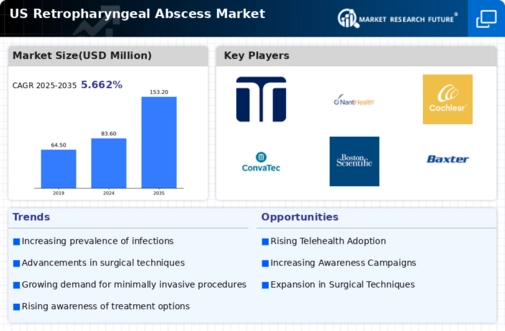Rising Healthcare Expenditure
The rising healthcare expenditure in the US is a significant driver for the retropharyngeal abscess market. As healthcare budgets expand, there is an increased allocation of funds towards advanced diagnostic and treatment options for various medical conditions, including retropharyngeal abscesses. This trend is reflected in the growing investments in healthcare infrastructure and technology, which facilitate better patient care. According to recent data, healthcare spending in the US is projected to reach approximately $4 trillion by 2025, indicating a robust market environment for medical services. Consequently, this financial commitment is likely to enhance the availability and accessibility of treatments for retropharyngeal abscesses, thereby stimulating market growth. The retropharyngeal abscess market stands to benefit from this upward trend in healthcare investment.
Increased Awareness of Symptoms
The growing awareness of the symptoms associated with retropharyngeal abscesses is a crucial driver for the retropharyngeal abscess market. Healthcare professionals and the general public are becoming more informed about the signs of this condition, such as difficulty swallowing, fever, and neck stiffness. This heightened awareness leads to earlier diagnosis and treatment, which is essential for preventing complications. As a result, the demand for diagnostic services and treatment options is likely to increase. In the US, the number of patients seeking medical attention for these symptoms has risen, contributing to a projected market growth of approximately 5% annually. This trend indicates a shift towards proactive healthcare, which is expected to positively impact the retropharyngeal abscess market in the coming years.
Increase in Pediatric Population
The increase in the pediatric population in the US is a notable driver for the retropharyngeal abscess market. Children are particularly susceptible to infections that can lead to retropharyngeal abscesses, making this demographic a critical focus for healthcare providers. As the birth rate stabilizes and the pediatric population continues to grow, the incidence of conditions requiring medical attention, including retropharyngeal abscesses, is likely to rise. This demographic shift suggests a potential increase in healthcare services tailored to children, which could lead to a market growth of approximately 4% in the coming years. The retropharyngeal abscess market is expected to adapt to these changes by enhancing pediatric care protocols and treatment options.
Technological Advancements in Treatment
Technological advancements in treatment modalities are significantly influencing the retropharyngeal abscess market. Innovations such as minimally invasive surgical techniques and improved antibiotic therapies are enhancing patient outcomes and reducing recovery times. For instance, the introduction of endoscopic procedures allows for more precise drainage of abscesses, minimizing the need for extensive surgeries. Furthermore, the development of new antibiotics that target resistant strains of bacteria is crucial, as it addresses the growing concern of antibiotic resistance. The US market is witnessing an increase in the adoption of these advanced treatment options, which could lead to a market growth rate of around 6% over the next few years. This evolution in treatment approaches is likely to attract more healthcare providers to the retropharyngeal abscess market.
Emerging Research and Clinical Guidelines
Emerging research and updated clinical guidelines are shaping the retropharyngeal abscess market. Ongoing studies are providing new insights into the etiology, diagnosis, and management of retropharyngeal abscesses, which are essential for improving patient care. As healthcare professionals adopt these new guidelines, there is likely to be a shift in treatment practices, leading to more standardized and effective approaches. This evolution in clinical practice is expected to enhance the quality of care and potentially reduce the incidence of complications associated with retropharyngeal abscesses. The retropharyngeal abscess market may experience growth as healthcare providers align their practices with the latest research findings, fostering a more informed and effective treatment landscape.





















Leave a Comment